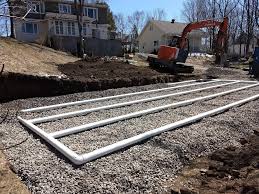Why Septic Tank Pumping Is Important
A little trivia: an average home with two baths and three occupants can produce about 250 to 300 gallons of wastewater per day. That is a lot of flow for an on-site septic system to treat and process. This is why regularly pumping your septic tank is perhaps the most important factor in maintaining your septic system. A neglected septic system can quickly become a health hazard and an expensive problem all around. Just as you would regularly have your car serviced every few thousand miles, you should likewise clean your septic tank after a few thousand flushes and laundry loads.
Septic tank pumping is basic septic maintenance that should be done regularly. On average, septic pumping is done every 2 to 5 years, depending on multiple factors. In other terms, when the sludge and scum levels reach 30% of the tank’s capacity, it’s time to pump your septic tank. Understanding how your septic tank and the system operates, proper septic tank care, adequate septic tank pumping frequency, and other septic maintenance tasks, will contribute significantly in maximizing the life of your system and will ensure its healthy working condition throughout.
Get Your Septic Tank Pumped By Local Expert Here
The most common domestic wastewater treatment system used in rural areas is the septic tank-soil absorption system. In a conventional, functional septic tank, we find wastewater which consists of a solid sludge layer at the bottom, watery sewage (effluent) in the middle, and a floating scum layer at the top. Helpful bacteria further digest the settled solid matter as effluent leaves the tank towards the drainfield. This soil absorption field then filters and treats the clarified septic tank effluent and disperses it through the soil.
The septic tank facilitates the removal of solids by holding wastewater in the tank for at least 24 hours. This allows the heavier solids to settle as sludge and the lighter particles to form scum at the top. This removal of solid waste matter from the effluent protects the drainfield from clogging and eventual failure. Besides removing solids, the septic tank also promotes biological digestion (by bacteria) of the solids and stores the remaining undigested portion, which is about 50% of the actual solid matter content.
Simply put, as a septic system is utilized, sludge continues to accumulate in the base part of the septic tank. Well-designed septic tanks have enough space to hold up to three years’ worth of sludge accumulation, but in reality, the actual time you have between septic tank pump-outs depends on your tank size and property’s level of usage.
Get Local Septic Tank Service Here
Basically, a septic tank pump-out is required when the thickness of the floating scum layer and settled sludge layer occupy so much of the tank’s total volume that the effluent area becomes “too small” that the effluent retention time (the time that wastewater is allowed for solids and floating scum to separate from effluent before being discharged to the drainfield) likewise becomes too short. Short septic tank effluent retention time means your tank is pushing solids into the drainfield, clogging it up and compromising its lifespan.
You should have your septic tank pumped when you observe any of the following:
- Total depth of scum + sludge layers equals 1/3 of the actual depth of the septic tank
- The bottom of the septic tank outlet baffle has less than 3 inches of clearance from the base of the floating scum layer
- The bottom of the outlet baffle is less than 6 inches away from the top of the sludge layer at the tank’s bottom
For a septic tank pumping to be effective, the settled sludge and floating scum layers need to be removed from the tank and not just the liquid effluent. Your septic provider may use a long-handled hoe-like tool to scrape and stir up the dense sludge at the bottom of the septic tank, mixing in a bit of liquid so that the vacuum hose can suck the sludge out of the tank.
The main objective of pumping a septic tank is to remove the solids (sludge and scum) from the septic tank and thus increasing the tank’s effluent retention time. For a septic tank pumping to be effective, the scum and sludge need to be removed by moving the pumping hose around the tank and using the effluent to help break up the solids for easier pumping out. If the pumper is merely pumping out the liquid effluent, then the objective of septic pumping is not being met. Just pumping out the liquid effluent is not beneficial to the system. In fact, leaving the solids behind means that the actual remaining tank volume available for wastewater treatment is less.
Whenever you have your septic tank pumped, you should monitor to ensure that your service provider is fully removing the sludge and scum. Experts recommend pumping your septic tank before anticipated heavy usage. In other words, plan ahead and get your tank pumped before family reunions, large parties, and other special occasions that spell a high volume of toilet, kitchen, and laundry users in your home or establishment. This is to ensure that the system performance is at its optimum for you and your guests. It makes sense to pump the tank after heavy usage, too – though pumping it beforehand reduces the chance of a sewage backup into your building during the big event when several people are present.
Get Local Septic Tank Service Here
Septic tank pump and haul contractors are skilled and equipped to clean your tank. Nevertheless, it is a good idea to supervise cleaning to make sure that it is accomplished properly. To be able to effectively extract all the waste from the tank, the scum layer needs to be broken up and the sludge layer needs to be mixed with the liquid contents of the tank.
Usually, this is accomplished by alternately pumping liquid from the tank and re-injecting it into the bottom part of the tank. Take note that the septic tank should be pumped through the large central manhole and not the baffle inspection ports. Doing so through the latter can damage the baffles, resulting in a compromised drainfield.
During a septic tank pump-out, it is ideal that you allow your service provider to conduct an inspection of your septic tank, as well. Doing so uncovers helpful information about the status of your drainfield.
During septic tank pumping, your
service provider should watch out for noise from drainfield back-flow. Effluent
should be flowing from the septic tank and into the drainfield. If you or your
septic pumper observes (or hears) septic effluent flowing back into the septic
tank through the outlet pipe, this is a possible indication that the drainfield
is waterlogged. If effluent is flowing backwards, it’s possible that there is
standing water in the drainfield and it is flooded and not functioning properly.
Further investigation of the noise and back-flow is required to confirm a
system failure.
When the
effluent in the septic tank is just below the level of the outlet line,
your service provider should start watching out for any back-flow noise. This
is when you would most likely hear back-flow from the drainfield. It is too
long if you wait until the whole tank is empty as the water or effluent that’s
been lodging at your drainfield may have already emptied itself into the septic
tank and been pumped out to the truck.
An efficient pumper specialist is equipped with a couple hundred feet of hose so that they can pump your tank from the driveway or side of the road, ideal for small-lot properties. Also, when your septic provider digs up the cover to your tank, they should know set the unearthed grass aside and put the dirt on a separate pile. Once done, they should be able to carefully replace the dirt with the sod back on top of your septic cover.
What You Need to Pump a Septic Tank
Just before your septic tank is pumped, accurately measuring the scum and sludge layers and will tell you the condition of your septic system. The depth of the scum layer and sludge layer in your septic tank provide key information about two things: whether or not the tank is being pumped enough and whether or not there is damage to the septic drainfield from the frequency and regularity of pumping your tank has undergone.
The sludge and scum measuring tube can be constructed with acrylic plastic or a PVC plastic pipe which is more readily available locally. You will also need a rubber ball that is a bit larger than the inside diameter of the pipe, some string, a washer, cotter pin or wire, and a scrap of wood for a handle. The length of the tube needs to be enough to safely reach the tank bottom without you needing to lean over or reach into the tank, but not too long so it is easy to handle. Eight feet is a good measurement. But if the bottom of your septic tank is only about 4 or 5 feet underground, you may cut off the excess length off the tube.
Get Local Septic Tank Service Here
Ideally, septic pumping is conducted by a septic professional. Septic pumping trucks are specialized vehicles which are equipped with a powerful vacuum pump and a holding tank for sewage and wastewater.
Before everything can begin, the septic pumping truck operator needs to locate your septic tank and remove its lid. After this, an initial action to start breaking up the floating scum layer and settled sludge layer inside the septic tank can be underway.
The pumper operator may use a muck rake to stir sludge layer on the tank bottom as well as the floating scum layer during pumping to facilitate their removal. A few minutes are spent with this tool before actual pumping can begin. During pumping, the operator should continue the use of the muck rake (or similar) to break up and pump out the contents of the tank.
The operator moves both the vacuum line and the muck rake continuously throughout the pumping operation, breaking up scum and sludge, mixing these with effluent in the tank, removing them with the vacuum hose. This continuous process allows for the easy removal with the vacuum hose.
After the successful removal of the scum layer and the first several inches of effluent, an efficient septic pumper operator may pause the operation, even shutting off the pumper truck for a moment to listen into the tank. The reason for this is to check if you can hear septic effluent spilling back into the septic tank through the tank outlet line. Hearing so is an indication that the drain field is saturated, failing, and possibly in need of replacement. This is valuable information which is detectable during septic tank pumping.
Get Local Septic Tank Service Here
Also, if your septic tank is made of plastic or fiberglass, it may have a bottom or side plug. Your pumper operator should be careful about possible accidental removal or loss of the tank plug during pumping. Without the plug, the tank will drain improperly into the surrounding soil. Lost plugs will need prompt replacement.
When to Pump Your Septic Tank
On average, a household or facility with four occupants, it is recommended that septic pumping is done once every 2 to 5 years. In other terms, when the sludge and scum levels reach 30% of the tank’s capacity, your septic tank is in need of pumping. Generally, the frequency of septic tank pumping depends on many different factors like the size of the septic tank, personal habits, and water usage. And because there is likely variance due to these factors, regular inspection is likewise recommended to determine the true condition of your septic system.
Generally, septic tanks need to be pumped every 2 to 5 years, with possible variances depending on the number of users in the property. The thickness of both the floating scum and settled sludge layers in a septic tank are the primary keys to determining if a tank actually needs to be pumped. The best person to recommend appropriate maintenance procedures and frequency of pumping that’s suitable for your type of septic system is your trusted septic professional service provider.
Well-designed septic tanks will typically have enough space for up to 3 years’ worth of accumulation of sludge, but the actual time you should allow between septic tank pump-outs will depend mostly on your tank’s size and the occupants’ level of usage. When the sludge level reaches beyond the maximum design point, sewage is left with less time to settle as scum or sludge before leaving the tank, thus more suspended sewage solid matter will tend to flow out of the septic tank with the effluent the drainfield.
If sludge is allowed to infiltrate the drainfield, this compromises the drainfield’s life span, possibly leading to system failure due to clogging of the absorbing soils around the field. To prevent this from happening, the septic tank must be pumped according to the proper schedule.
Below is a list of other reasons to pump your septic tank:
Before a party or gathering. You can reduce the likelihood of septic system backup, as well as avoiding overloading the drainfield, if you have your septic tank pumped right before any anticipated heavy usage. If you are expecting many visitors or hosting a large party with many guests in your home or establishment, pumping your septic tank is recommended.
Sewage backups. Pumping your septic tank when you notice sewage are backing up in your drains is a “band aid” solution that affords you a very brief relief since the tank will fill up again quickly, perhaps in just a day or so of use. It is important that the cause of the septic backup is determined as soon as possible. For instance, if the system is backing up because the tank is severely blocked by solid waste, the tank needs to be pumped immediately. However, know that when this happens, it is highly likely that your drainfield has been damaged and cannot be expected to function for too long. If the system is backing up because the drainfield itself is failing and is no longer accepting effluent, your drainfield needs to be replaced.
Clogged septic system drains. When your drains are slow, there is a possible clog within the system and needs to be found and cleared promptly.
Flooded
septic tank. Septic tanks subjected to flooded conditions need to be pumped
and inspected immediately as the tank may have been filled with silt or mud
that could back up.
Observed signs of septic failure. When you notice effluent anywhere
on your property’s surface or in the area of the drainfield and/or foul odors
that seem to persist, it might be a good idea to get your septic tank pumped. Although,
keep in mind that just pumping is a futile attempt and is very short-term. Other
diagnosis and repair procedures may be required.
Remember that sewage gas leakage problems will not be corrected by just pumping out the septic tank. Pumping is only a primary step to allow for a more thorough inspection so you may get critical information about your septic system’s condition.
When NOT to Pump a Septic Tank
Under certain conditions, pumping the septic tank may be unsafe, or may even lead to damage to the septic system. When is it not ideal to pump out a septic tank?
When your septic system is flooded due to a storm. A flooded septic tank that’s logged by area flooding (from a storm, hurricane, or a river over-flow) should not be pumped out. Pumping out a septic tank when ground waters are still flooding the area of your septic tank can result to unexpected problems. You had better wait until floodwaters have receded and ground water is low enough. This way, mud, silt, and floodwater won’t just flow back into the tank.
When a Septic Tank is old, fragile, or of uncertain condition. Do not pump an old septic tank especially if it’s been built out of dry-laid stone or concrete block. An aged septic tank of unknown conditions could have weakened over the years and is already at risk of collapsing when pumped. It is also possible that it collapses shortly after a pump-out. If you do not have information about what your septic system is made of, like if it’s actually a conventional septic tank-and-drainfield system or a simple cesspool, be sure that your septic contractor proceeds with the pump-out with appropriate care. In cases like this, your contractor should take caution and pump only a portion of the contents from high in the tank – just enough to be able to inspect (perhaps, with a flashlight and a mirror attached to a pole) the interior and gain visibility of how it’s constructed and what its current condition is.
If the sludge level and scum layer thickness in the tank are minimal. If the sludge level inside the septic tank is low, like maybe just an inch or two in a 5-foot deep tank, and the floating scum layer thickness is likewise minimal, also an inch or two, the only good reason to pump the tank anyway is only if there is a need to inspect or repair it. It’s possible to estimate the depths of the sludge and scum layers using probes especially fabricated for that purpose. Take note, however, that measuring the scum and sludge layers’ thickness inside a septic tank is can be unsafe due to risks of falling into tank, methane exposure, etc. It is ideal to allow septic professional service providers to undertake this task.
The Cost of Pumping a Septic Tank
Under normal conditions, the ideal
timetable to pump a septic tank system is once every 1 to 3 years. But this may
vary depending on the number of occupants in the property. Below is a quick
guide: Number of Occupants Pump Every: 1
to 2 3
years 3 to 5 2
years 6
or more 1
year
There is a number of factors to consider for more specific costing. Generally, the costs will depend on how many tanks you have, where your system is located, and how accessible it is to the service provider. Some questions that your contractor will likely ask to determine the costs of pumping a septic tank are:
- Do you know where you tank is located? Do you have an as-built of the system?
- How many tanks do you have?
- Is it accessible (i.e., location and is it buried)?
- Has the system been remodeled, renovated, or modified?
- When was the last time you had it serviced?
You may need to consult with your local contractor regarding your specific household or business situation.
Septic tank pumping costs may range from $75 to $200, typically. However, it may run as high as $300 (or more) in some parts of the country. Say, for example, that getting your septic tank pumped costs you $150 and you are having it done every 3 years. That comes out to $50 per year for sewage treatment. If you have your tank pumped every 2 years, it is $75. On the other hand, if you are connected to a centralized local sewer system, you would be paying your local government somewhere around $300 to $800 for that same year of treatment. Thinking about it this way highlights a cost advantage of maintaining a dedicated on-site waste treatment over a centralized sewer system.
After Septic Pumping: What’s Next?
A septic tank in normal use is always full, ideally right up to just below the outlet pipe. After having it pumped out completely, an empty septic tank fills up again in just a few days, under normal usage, after which it will again be discharging effluent to the drainfield.
The failure to pump your septic tank frequently enough may lead to a premature drainfield failure and/or other costly repairs. On the flip-side, pumping or cleaning out a septic tank much too frequently is just wasting money. Though, yes – you’d be “wasting” a lot less money this way than the cost of a new drainfield.
When you need to have your septic
tank pumped out again and how frequently thereafter can be determined after
considering information about the actual septic system: your tank’s capacity, its
size, your system’s level of usage, age, and other factors.
There is a theory
is that you need to pump the septic tank after heavy usage to get it “back to
normal”. Like after you’ve hosted a days-long reunion or a lavish party. It
might be smarter to pump the septic tank before or both before and after heavy
use when we know a septic system is marginal in terms of capacity. But doing so
every time can get pretty expensive.
To facilitate cleaning and inspection of your septic tank in the future, install risers from the manhole and inspection ports to the surface, if you don’t already have such inspection and cleaning access ports. Also, be sure that the septic tank lid(s) and access port covers are all in good condition and completely safe. A bad septic tank, drywell, or cesspool cover can cause a collapse and can be fatal to someone who may be there “in the wrong place at the wrong time”. Before burying the tank, remember to measure from a fixed landmark and mark the location of the tank, so it can be easily identified.
Keep in mind that pumping the septic tank may provide temporary improvements to toilet flushing, but it’s not enough to repair a clogged drain nor a failing drainfield. The failure to properly maintain any septic system is the leading cause of early septic system failures.
The proper care of your septic tank extends the life cycle of your dedicated on-site sewage management system and will substantially save you money by preventing costly repairs or replacements. Regular septic maintenance, more importantly, protects your family’s health and upholds the quality of your community’s water resources. Responsible septic system ownership is actually mandated by local laws and ordinances. Failed septic systems bring with it expensive property damage and a steep decline in your property’s actual value. When the time comes that you decide to sell your property, it will be a critical factor that your septic system has been maintained properly and that it is in good functioning condition.
Get Your Septic System Pumped
Visit our State Directory For Local Septic Service Providers
Resources
https://inspectapedia.com/septic/Septic_Tank_Pumping_Procedure.php
https://inspectapedia.com/septic/Septic_Tank_Cleaning.php
https://inspectapedia.com/septic/Septic_Pumper_Truck_Operation.php
https://inspectapedia.com/septic/Septic_Tank_Pumpout_Details.php
https://www.flohawks.com/blog/what-to-expect-when-your-septic-tank-gets-cleaned/
https://medium.com/waste-disposal-hub/how-septic-tanks-work-and-when-to-empty-them-346a4fe4fe6f
https://home.howstuffworks.com/home-improvement/plumbing/septic-tank-cleaning.htm
https://inspectapedia.com/septic/Septic_Tank_Checks_While_Pumping.php
https://inspectapedia.com/septic/Sewage_Level_Measuring_Tools.php
https://www.mrrooter.com/about/blog/2018/september/chart-how-often-should-a-septic-tank-be-pumped-o/
https://extension.psu.edu/septic-tank-pumping
https://williamdustinseptic.com/lakeland-septic-services-blog/kind-equipment-septic-tank-pumping/
https://inspectapedia.com/septic/Septic_Tank_Locating_Tools.php
https://blog.lyttleco.com/septic-tank-maintenance/how-to-tell-if-your-septic-tank-is-full-0
https://paradisevalleyseptic.com/7-signs-you-need-to-pump-your-septic-tank/
https://inspectapedia.com/septic/Septic_Tank_Pumping_Schedule.php
https://homeguides.sfgate.com/can-plugged-septic-tank-cause-indoor-plumbing-problems-89535.html
https://laundry-alternative.com/blogs/news/cost-of-pumping-a-septic-tank
https://inspectapedia.com/septic/Do_Not_Pump_Septic_Tank.php
https://inspectapedia.com/septic/Septic_Tank_Cleaning_Mistakes.php











